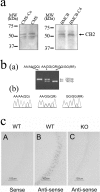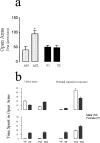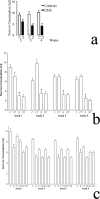Brain neuronal CB2 cannabinoid receptors in drug abuse and depression: from mice to human subjects
- PMID: 18286196
- PMCID: PMC2241668
- DOI: 10.1371/journal.pone.0001640
Brain neuronal CB2 cannabinoid receptors in drug abuse and depression: from mice to human subjects
Abstract
Background: Addiction and major depression are mental health problems associated with stressful events in life with high relapse and reoccurrence even after treatment. Many laboratories were not able to detect the presence of cannabinoid CB2 receptors (CB2-Rs) in healthy brains, but there has been demonstration of CB2-R expression in rat microglial cells and other brain associated cells during inflammation. Therefore, neuronal expression of CB2-Rs had been ambiguous and controversial and its role in depression and substance abuse is unknown.
Methodology/principal findings: In this study we tested the hypothesis that genetic variants of CB2 gene might be associated with depression in a human population and that alteration in CB2 gene expression may be involved in the effects of abused substances including opiates, cocaine and ethanol in rodents. Here we demonstrate that a high incidence of (Q63R) but not (H316Y) polymorphism in the CB2 gene was found in Japanese depressed subjects. CB2-Rs and their gene transcripts are expressed in the brains of naïve mice and are modulated following exposure to stressors and administration of abused drugs. Mice that developed alcohol preference had reduced CB2 gene expression and chronic treatment with JWH015 a putative CB2-R agonist, enhanced alcohol consumption in stressed but not in control mice. The direct intracerebroventricular microinjection of CB2 anti-sense oligonucleotide into the mouse brain reduced mouse aversions in the plus-maze test, indicating the functional presence of CB2-Rs in the brain that modifies behavior. We report for the using electron microscopy the sub cellular localization of CB2-Rs that are mainly on post-synaptic elements in rodent brain.
Conclusions/significance: Our data demonstrate the functional expression of CB2-Rs in brain that may provide novel targets for the effects of cannabinoids in depression and substance abuse disorders beyond neuro-immunocannabinoid activity.
Conflict of interest statement
Figures








Similar articles
-
Functional expression of brain neuronal CB2 cannabinoid receptors are involved in the effects of drugs of abuse and in depression.Ann N Y Acad Sci. 2008 Oct;1139:434-49. doi: 10.1196/annals.1432.036. Ann N Y Acad Sci. 2008. PMID: 18991891 Free PMC article.
-
Neuropsychobiological evidence for the functional presence and expression of cannabinoid CB2 receptors in the brain.Neuropsychobiology. 2006;54(4):231-46. doi: 10.1159/000100778. Epub 2007 Mar 15. Neuropsychobiology. 2006. PMID: 17356307
-
Discovery of the presence and functional expression of cannabinoid CB2 receptors in brain.Ann N Y Acad Sci. 2006 Aug;1074:514-36. doi: 10.1196/annals.1369.052. Ann N Y Acad Sci. 2006. PMID: 17105950 Review.
-
Methods to study the behavioral effects and expression of CB2 cannabinoid receptor and its gene transcripts in the chronic mild stress model of depression.Methods Mol Med. 2006;123:291-8. doi: 10.1385/1-59259-999-0:291. Methods Mol Med. 2006. PMID: 16506415
-
CNS effects of CB2 cannabinoid receptors: beyond neuro-immuno-cannabinoid activity.J Psychopharmacol. 2012 Jan;26(1):92-103. doi: 10.1177/0269881111400652. Epub 2011 Mar 29. J Psychopharmacol. 2012. PMID: 21447538 Free PMC article. Review.
Cited by
-
Effects of β -caryophyllene, A Dietary Cannabinoid, in Animal Models of Drug Addiction.Curr Neuropharmacol. 2023;21(2):213-218. doi: 10.2174/1570159X20666220927115811. Curr Neuropharmacol. 2023. PMID: 36173065 Free PMC article.
-
Decreased cocaine motor sensitization and self-administration in mice overexpressing cannabinoid CB₂ receptors.Neuropsychopharmacology. 2012 Jun;37(7):1749-63. doi: 10.1038/npp.2012.22. Epub 2012 Mar 14. Neuropsychopharmacology. 2012. PMID: 22414816 Free PMC article.
-
G-protein receptor kinase 5 regulates the cannabinoid receptor 2-induced up-regulation of serotonin 2A receptors.J Biol Chem. 2013 May 31;288(22):15712-24. doi: 10.1074/jbc.M113.454843. Epub 2013 Apr 16. J Biol Chem. 2013. PMID: 23592773 Free PMC article.
-
Role of CB2 cannabinoid receptors in the rewarding, reinforcing, and physical effects of nicotine.Neuropsychopharmacology. 2013 Nov;38(12):2515-24. doi: 10.1038/npp.2013.157. Epub 2013 Jul 2. Neuropsychopharmacology. 2013. PMID: 23817165 Free PMC article.
-
Reviewing the Role of the Endocannabinoid System in the Pathophysiology of Depression.Front Pharmacol. 2021 Dec 6;12:762738. doi: 10.3389/fphar.2021.762738. eCollection 2021. Front Pharmacol. 2021. PMID: 34938182 Free PMC article. Review.
References
-
- Degenhardt L, Hall W, Lynskey M. Alcohol, cannabis and tobacco use among Australians: a comparison of their associations with other drug use and use disorders, affective and anxiety disorders, and psychosis. Addiction. 2001;96:1603–1614. - PubMed
-
- Willner P. Chronic mild stress (CMS) revisited: consistency and behavioural-neurobiological concordance in the effects of CMS. Neuropsychobiology. 2005;52:90–110. - PubMed
-
- Volkow ND, Li TK. Drugs and alcohol: treating and preventing abuse, addiction and their medical consequences. Pharmacol Ther. 2005;108:3–17. - PubMed
-
- Manzanares J, Uriguen L, Rubio G, Palomo T. Role of endocannabinoid system in mental diseases. Neurotox Res. 2004;6:213–224. - PubMed
-
- Vinod KY, Hungund BL. Role of the endocannabinoid system in depression and suicide. Trends Pharmacol Sci. 2006;27:539–545. - PubMed
Publication types
MeSH terms
Substances
LinkOut - more resources
Full Text Sources
Medical
Molecular Biology Databases

